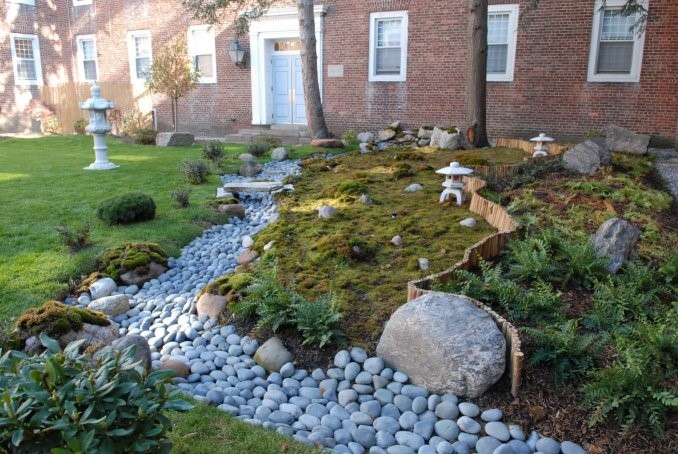Japanese Zen Garden
During the 8th century garden designers and story tellers in Japan were inspired by the tale of a fisherman named Urashima Taro. Urashima saved the life of a sea turtle and in return was taken to one of five immortal islands. Gardens began to take on the nature of the five island concept.
Then during the Heian Period (8th – 12th century) inspiration began to come from Japanese natural landscapes and Buddhism. The idea of death and rebirth was embraced and use of elements and colors that changed with the seasons became more prominent. Dry rock landscapes also began to emerge.
Later in the 14th century, the Muromachi Period, Muso Soseki, a Zen monk, brought great popularity to Zen landscaping with his technique and designs. The use of rock and sand became widespread and the idea that rocks, pebbles, and gravel could represent elements in nature like water, animals, mountains and islands was adopted. Gardens and gardeners of this period left a legacy that is used in garden design and development to this day.
In the 21st century, Japanese Zen gardens continue to be built around the word.
Information taken from: “The meaning behind the mystery of Japanese Zen gardens”
by Robin Lane Fox
Purpose and Design of the Garden
The North Country Garden, which was opened in the fall of 2008, was created through collaboration between Professor Mark MacWilliams and Professor Catherine Shrady. Combining an Asian Studies Initiative grant and a grant from the Dolan Family for building an outdoor geology lab, the idea of a traditional Japanese Zen garden with an Adirondack twist was born. Working with a group of St. Lawrence University students, Professor MacWilliams and Professor Shrady designed and built the garden following a trip to Japan. The garden was to be a place for quiet reflection as well as a living classroom for the arts, humanities and the sciences, specifically biology and geology.
The garden is located in the courtyard of Sykes Residence Hall. This conveniently allows the garden to connect the two sides of campus – the southern side is sciences and the northern is the home of the humanities and arts. The garden is enclosed within Sykes dormitory walls which shut out the busy world, creating a peaceful refuge for students, staff, faculty, and community members. All are welcome to visit the garden and enjoy its beauty, spirituality, and history.
Photo depicts - Furyû; The flowing elegance of gardens
"When a garden is used as a place to pause for thought, that is when a Zen garden comes to life. When you contemplate a garden like this it will form a lasting impression on your heart." - Muso Soseki
"Ode to the Dry Landscape"
Without a speck of dust being raised, the mountains tower up; without a single drop falling, the streams plunge into the valley. - Muso Soseki



